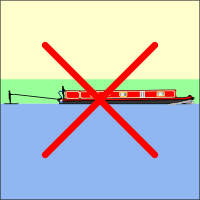Speed
There is a saying in driving circles which quotes: "As slow as possible and as fast as necessary".
The same can be said about inland waterways boating. There are times when a bit of speed is essential but most of the time the slowest speed possible is the order of the day. Water skiing is not allowed on the canals.
After all, why did you buy a boat? For many, the idea of owning a boat is to get away from the high speed motorway driving and slow down to a pace that is relaxing and gives you time to think and look at your surroundings.
There are speed limits on most inland waterways. They are there to prevent damage to the channel and to ensure everyone's safety and enjoyment.
On canals, the speed limit is 4 mph which is a steady walking pace.
There are times for a bit of "oomph" but often people confuse power and/or prop speed with boat speed. Use of power and prop speed may help to get you out of trouble on a windy day or help you make a tight manoeuvre but it will be more effective if you get the boat speed down first.
It is a good helmsman that sees where he/she will need to make a tight turn in advance and slows the boat down first.
Going faster often means slower on shallow canals.
Attempting to cruise too fast will actually slow your boat down and make it more difficult to handle as water struggles to get round or under your hull in the restricted channel. You are wasting engine fuel and damaging the environment.
A breaking wave is a sure sign that you are going too fast and causes much damage to the unprotected banks and habitats.